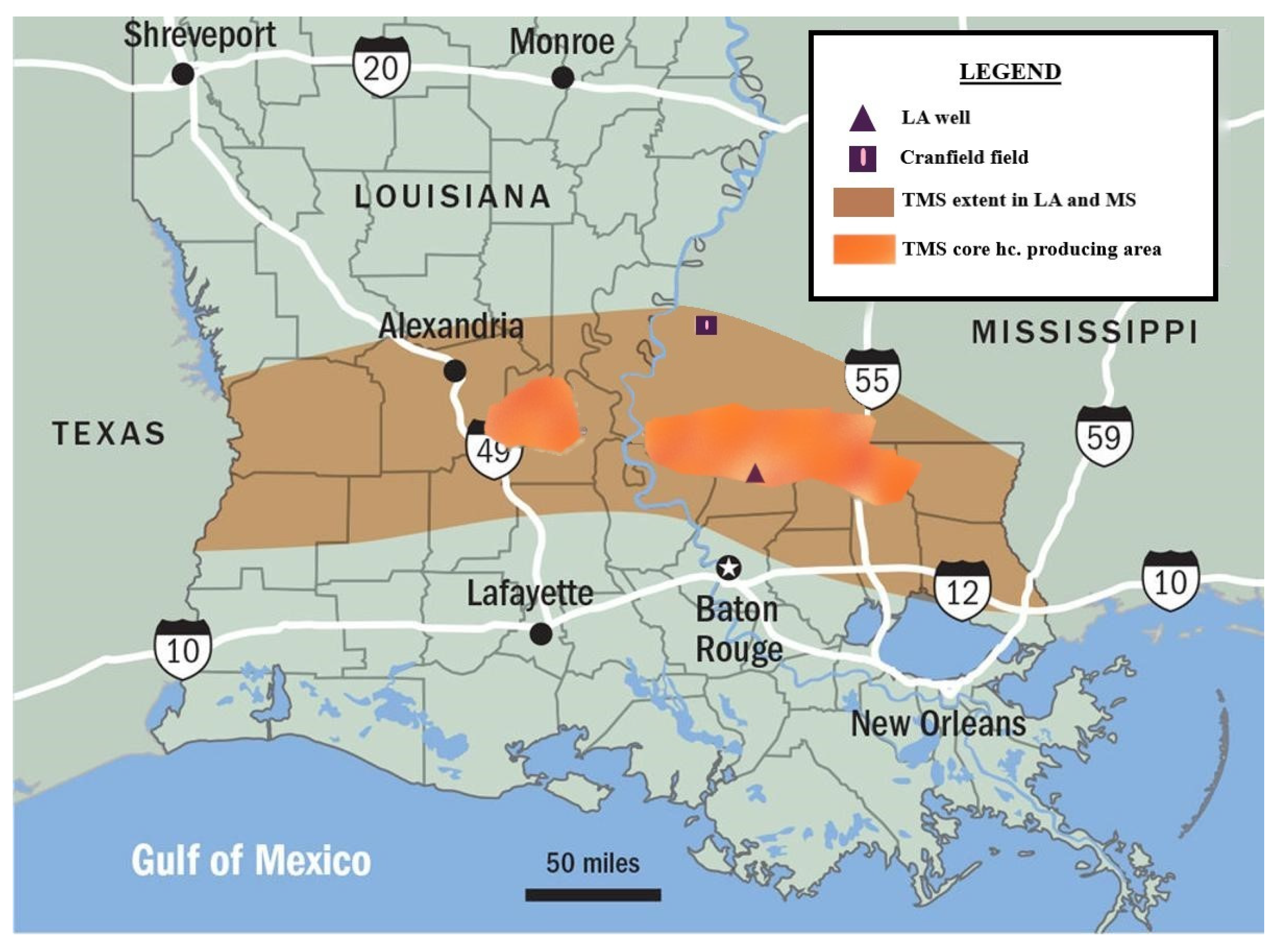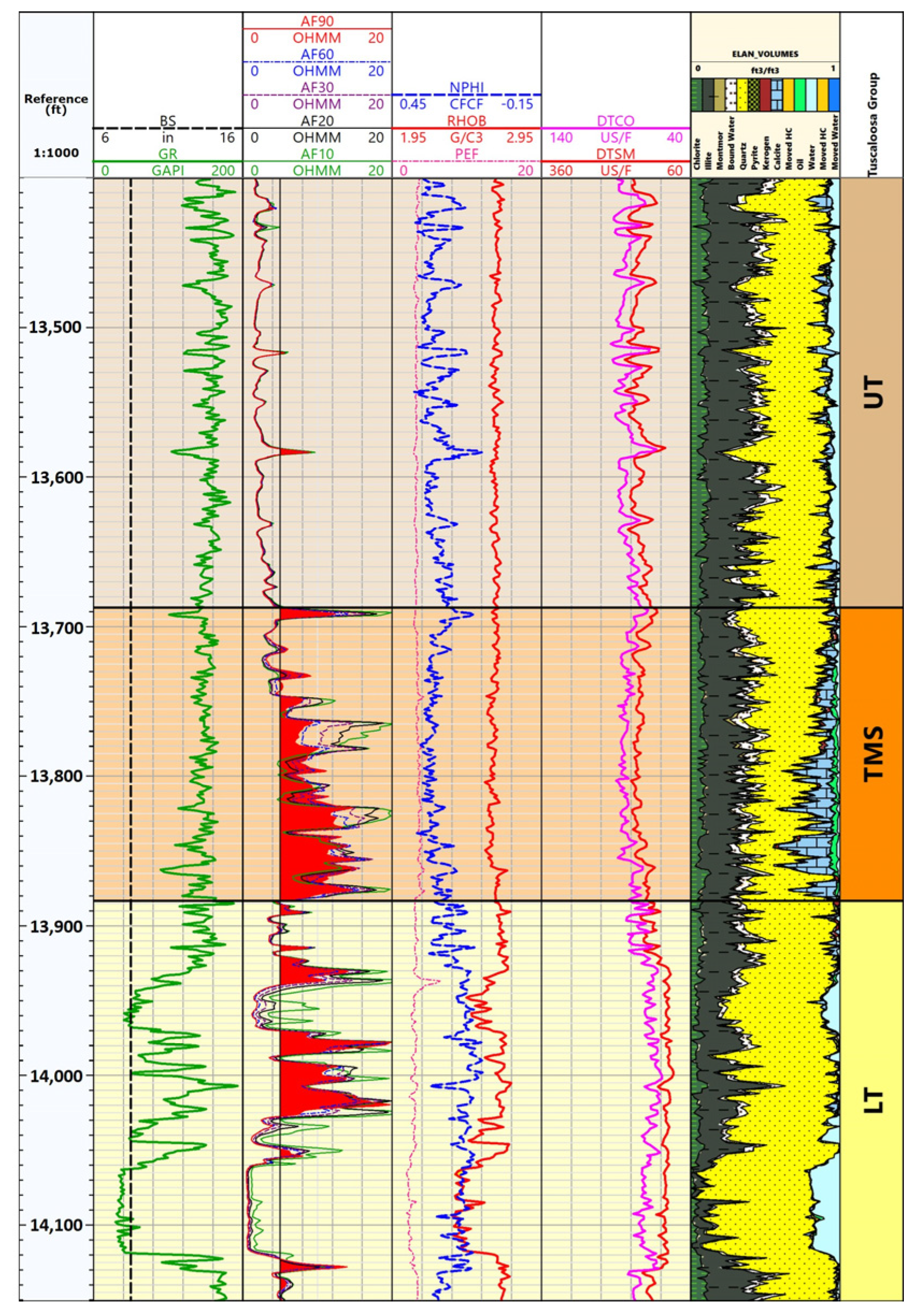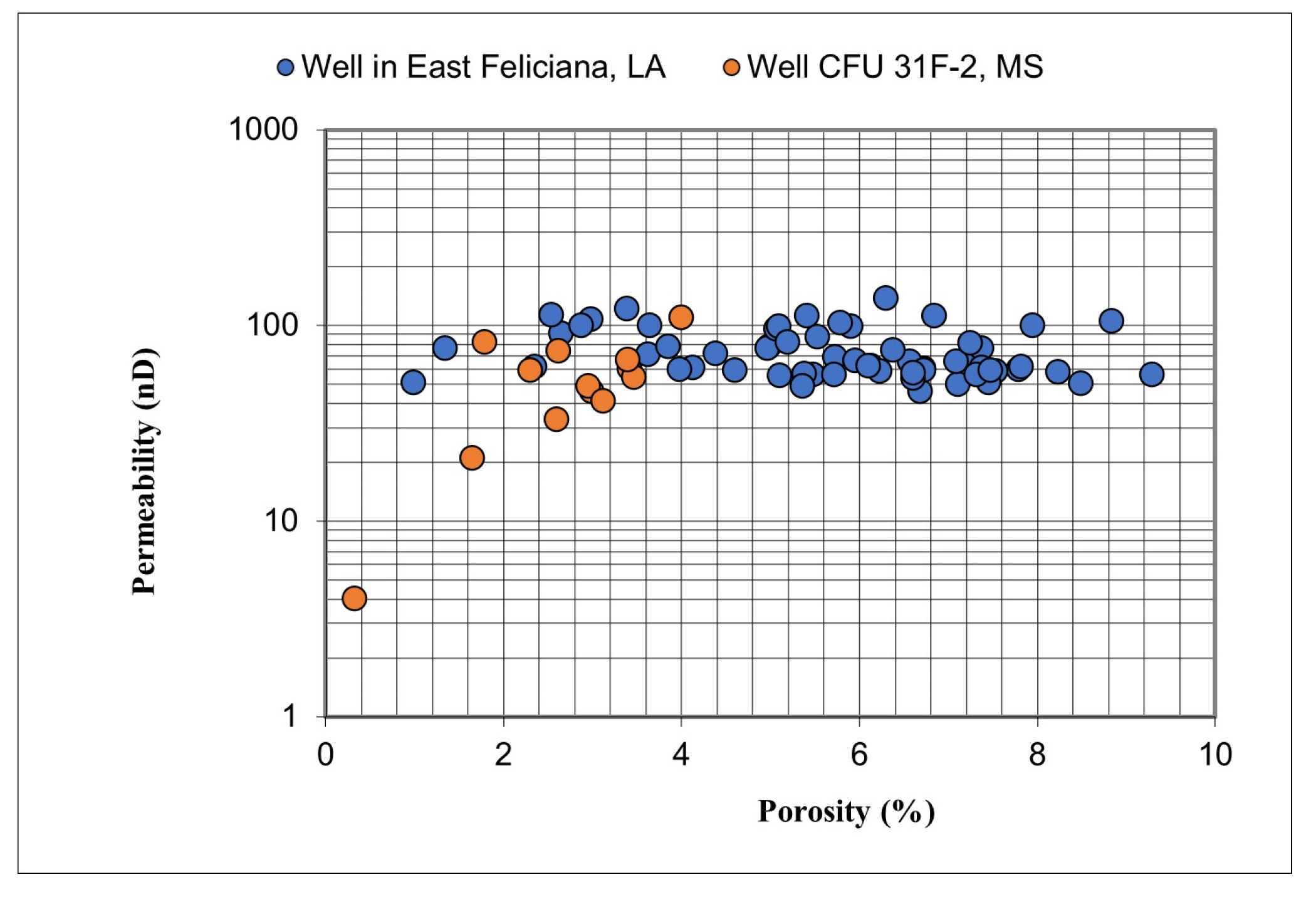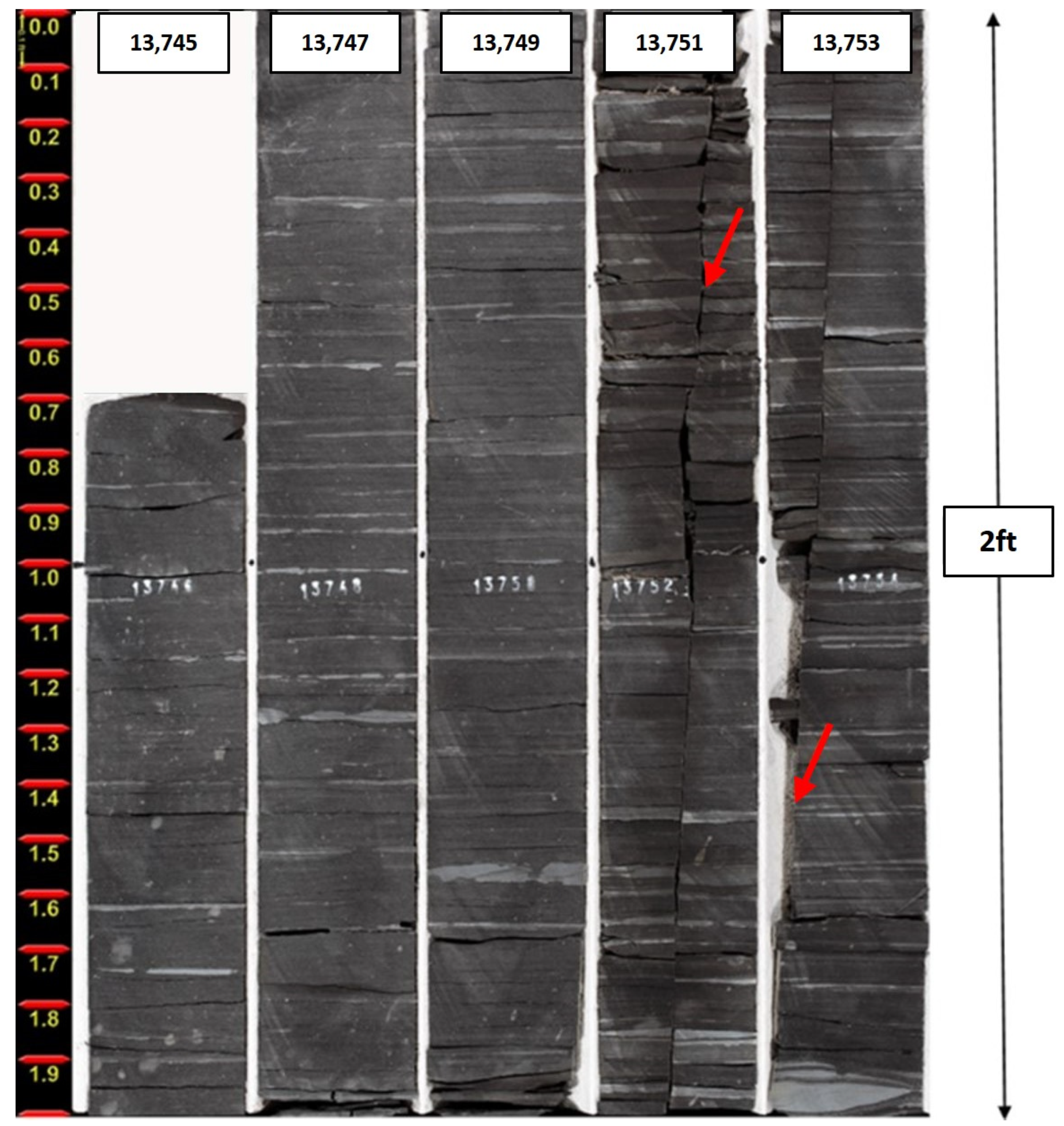Tuscaloosa Marine Shale: Seal or Source? Petrophysical Comparative Study of Wells in SE Louisiana and SW Mississippi
Abstract
:1. Introduction
Description of the Tuscaloosa Marine Shale
2. Data and Methods
3. Analysis and Results
3.1. Well Log Analysis
3.2. XRD Data Analysis
3.3. Porosity–Permeability Data Analysis
3.4. Organic Enrichment in the Tuscaloosa Marine Shale
3.5. Fracture Occurrence in the Tuscaloosa Marine Shale
4. Conclusions
Author Contributions
Funding
Institutional Review Board Statement
Informed Consent Statement
Data Availability Statement
Acknowledgments
Conflicts of Interest
References
- Koons, C.B.; Bond, J.G.; Peirce, F.L. Effects of depositional environment and postdepositional history on chemical composition of Lower Tuscaloosa oils. AAPG Bull. 1974, 58, 1272–1280. [Google Scholar]
- Smith, G.W. Decade of Exploration in Deep Lower Tuscaloosa Gas Trend in Southern Louisiana. AAPG Bull. 1985, 69, 308. [Google Scholar]
- Walters, C.C.; Dusang, D.D. Source and thermal history of oils from Lockhart Crossing, Livingston Parish, Louisiana. Trans. Gulf Coast Assoc. Geol. Soc. 1988, 38, 37–44. [Google Scholar]
- Borrok, D.M.; Yang, W.; Wei, M.; Mokhtari, M. Heterogeneity of the mineralogy and organic content of the Tuscaloosa Marine Shale. Mar. Pet. Geol. 2019, 109, 717–731. [Google Scholar] [CrossRef]
- Hovorka, S.D.; Meckel, T.A.; Trevino, R.H.; Lu, J.; Nicot, J.P.; Choi, J.W.; Freeman, D.; Cook, P.; Daley, T.M.; Ajo-Franklin, J.B.; et al. Monitoring a large volume CO2 injection: Year two results from SECARB project at Denbury’s Cranfield, Mississippi, USA. Energy Procedia 2011, 4, 3478–3485. [Google Scholar] [CrossRef] [Green Version]
- Lu, J.; Milliken, K.; Reed, R.M.; Hovorka, S. Diagenesis and sealing capacity of the middle Tuscaloosa mudstone at the Cranfield carbon dioxide injection site, Mississippi, USA. Environ. Geosci. 2011, 18, 35–53. [Google Scholar] [CrossRef]
- Elliot, T.R.; Celia, M.A. Potential Restrictions for CO2 Sequestration Sites Due to Shale and Tight Gas Production. Environ. Sci. Technol. 2012, 46, 4223–4227. [Google Scholar] [CrossRef]
- Nicot, J.-P.; Duncan, I.J. Common attributes of hydraulically fractured oil and gas production and CO2 geological sequestration. Greenh. Gas. Sci. Technol. 2012, 2, 352–368. [Google Scholar] [CrossRef]
- Katsube, T.J.; Williamson, M.A. Effects of diagenesis on shale nano-pore structure and implications for sealing capacity. Clay Miner. 1994, 29, 451–461. [Google Scholar] [CrossRef]
- Bolton, A.J.; Maltman, A.J.; Fisher, Q. Anisotropic permeability and bimodal pore-size distributions of fine-grained marine sediments. Mar. Pet. Geol. 2000, 17, 657–672. [Google Scholar] [CrossRef]
- Trujillo, N.; Rose-Coss, D.; Heath, J.E.; Dewers, T.A.; Ampomah, W.; Mozley, P.S.; Cather, M. Multiscale Assessment of Caprock Integrity for Geologic Carbon Storage in the Pennsylvanian Farnsworth Unit, Texas, USA. Energies 2021, 14, 5824. [Google Scholar] [CrossRef]
- Jahanbakhsh, A.; Liu, Q.; Hadi Mosleh, M.; Agrawal, H.; Farooqui, N.M.; Buckman, J.; Recasens, M.; Maroto-Valer, M.; Korre, A.; Durucan, S. An Investigation into CO2–Brine–Cement–Reservoir Rock Interactions for Wellbore Integrity in CO2 Geological Storage. Energies 2021, 14, 5033. [Google Scholar] [CrossRef]
- Fais, S.; Casula, G.; Cuccuru, F.; Ligas, P.; Bianchi, M.G.; Plaisant, A.; Pettinau, A. A Contribution to the Geological Characterization of a Potential Caprock-Reservoir System in the Sulcis Coal Basin (South-Western Sardinia). Energies 2019, 12, 4524. [Google Scholar] [CrossRef] [Green Version]
- Hadian, P.; Rezaee, R. The Effect of Supercritical CO2 on Shaly Caprocks. Energies 2020, 13, 149. [Google Scholar] [CrossRef] [Green Version]
- Lohr, C.D.; Hackley, P.C.; Valentine, B.J.; Enomoto, C.B. Thermal gradient trends in the Tuscaloosa Marine Shale play area: Preliminary results from studies to support oil and natural gas resources assessments. Gulf Coast Assoc. Geol. Soc. Trans. 2016, 66, 1099–1108. [Google Scholar]
- Hackley, P.C.; Enomoto, C.B.; Valentine, B.J.; Rouse, W.A.; Lohr, C.D.; Dulong, F.T.; Hatcherian, J.J.; Brennan, S.T.; Craddock, W.H.; Finn, T.M.; et al. Assessment of Undiscovered Continuous Oil and Gas Resources in the Upper Cretaceous Tuscaloosa Marine Shale of the U.S. Gulf Coast, 2018, Fact Sheet 2018–3043; U.S. Geological Survey: Reston, VA, USA, 2018; Volume 2. [CrossRef] [Green Version]
- Enomoto, C.B.; Hackley, P.C.; Valentine, B.J.; Rouse, W.A.; Dulong, F.T.; Lohr, C.D.; Hatcherian, J.J. Geologic characterization of the hydrocarbon resource potential of the Upper Cretaceous Tuscaloosa marine shale in Mississippi and Louisiana, USA. Gulf Coast Assoc. Geol. Soc. Trans. 2017, 67, 95–110. [Google Scholar]
- Shaibu, R.; Guo, B.; Wortman, P.B.; Lee, J. Stress-sensitivity of fracture conductivity of Tuscaloosa Marine Shale cores. J. Pet. Sci. Eng. 2022, 210, 110042. [Google Scholar] [CrossRef]
- Ahmadov, J.; Mokhtari, M. Experimental evaluation of ultrasonic velocities and anisotropy in the Tuscaloosa Marine Shale Formation. Interpretation 2020, 8, SL113–SL125. [Google Scholar] [CrossRef]
- Ruse, C.M.; Mokhtari, M. Characterization of elastic mechanical properties of Tuscaloosa Marine Shale from well logs using the vertical transversely isotropic model. Interpretation 2020, 8, T1023–T1036. [Google Scholar] [CrossRef]
- Ruse, C.M.; Ahmadov, J.; Liu, N.; Mokhtari, M. An Integrated Analytics and Machine Learning Solution for Predicting the Anisotropic Static Geomechanical Properties of the Tuscaloosa Marine Shale. In Proceedings of the SPE/AAPG/SEG Unconventional Resources Technology Conference, Austin, TX, USA, 20–22 July 2020. [Google Scholar] [CrossRef]
- Mlella, M.; Ma, M.; Zhang, R.; Mokhtari, M. Machine learning for geophysical characterization of brittleness: Tuscaloosa Marine Shale case study. Interpretation 2020, 8, T589–T597. [Google Scholar] [CrossRef]
- Spooner, H.V., Jr. Basal Tuscaloosa sediments, east-central Louisiana. AAPG Bull. 1964, 48, 1–21. [Google Scholar]
- Lowery, C.M.; Cunningham, R.; Barrie, C.D.; Bralower, T.; Snedden, J.W. The northern Gulf of Mexico during OAE2 and the relationship between water depth and black shale development. Paleoceanography 2017, 32, 1316–1335. [Google Scholar] [CrossRef] [Green Version]
- Snedden, J.W.; Galloway, W.E. The Gulf of Mexico Sedimentary Basin: Depositional Evolution and Petroleum Applications; Cambridge University Press: Cambridge, UK, 2019. [Google Scholar]
- Frascogna, X.M. Mesozoic-Paleozoic producing areas of Mississippi and Alabama: Jackson, MS. Miss. Geol. Soc. 1957, 1, 139. [Google Scholar]
- Lu, J.; Kordi, M.; Hovorka, S.D.; Meckel, T.A.; Christopher, C.A. Reservoir characterization and complications for trapping mechanisms at Cranfield CO2 injection site. Int. J. Greenh. Gas Control 2013, 18, 361–374. [Google Scholar] [CrossRef]
- Werren, E.G.; Shew, R.D.; Adams, E.R.; Stancliffe, R.J. Meander-belt reservoir geology, mid-dip Tuscaloosa, Little Creek field, Mississippi. In Sandstone Petroleum Reservoirs; Springer: New York, NY, USA, 1990; pp. 85–107. [Google Scholar]
- Allen, J.E., Jr.; Meylan, M.A.; Heitmuller, F.T. Determining hydrocarbon distribution using resistivity, Tuscaloosa Marine Shale, southwestern Mississippi. Gulf Coast Assoc. Geol. Soc. Trans. 2014, 64, 41–57. [Google Scholar]
- Rouse, W.A.; Enomoto, C.B.; Gianoutsos, N.J. Correlation of the Tuscaloosa marine shale in Mississippi, Louisiana, and East Texas, USA. Gulf Coast Assoc. Geol. Soc. Trans. 2018, 68, 461–475. [Google Scholar]
- John, C.J.; Jones, B.L.; Moncrief, J.E.; Bourgeois, R.; Harder, B.J. An unproven unconventional seven billion barrel oil resource—The Tuscaloosa Marine Shale. BRI Bull. 1997, 7, 1–22. [Google Scholar]
- Lohr, C.D.; Hackley, P.C. Using mercury injection pressure analyses to estimate sealing capacity of the Tuscaloosa marine shale in Mississippi, USA: Implications for carbon dioxide sequestration. Int. J. Greenh. Gas Control 2018, 78, 375–387. [Google Scholar] [CrossRef]
- Ezeakacha, C.P.; Mokhtari, M.; Ben Hmida, J. Evaluation of Porosity in Liquid-Rich Tuscaloosa Marine Shale. In Proceedings of the SPE/AAPG/SEG Unconventional Resources Technology Conference, Online, 20–22 July 2020. [Google Scholar] [CrossRef]
- Sassen, R. Lower Tertiary and Upper Cretaceous source rocks in Louisiana and Mississippi: Implications to Gulf of Mexico crude oil. AAPG Bull. 1990, 74, 857–878. [Google Scholar]
- Hart, B.S. Marine mudstone source rocks in epicontinental basins: Development of a conceptual facies model and application to Cenomanian/Turonian mudstones of the Cretaceous Western Interior Seaway. In Hydrocarbon Source Rocks in Unconventional Plays, Rocky Mountain Region; Dolan, M., Higley, D., Lillis, P., Eds.; Rocky Mountain Association of Geology Sp.Pub.: Denver, CO, USA, 2016; pp. 1–58. Available online: https://www.rmag.org/index.php?src=directory&srctype=detail&refno=4098&view=products&submenu=cart&back=products&id=4098 (accessed on 13 February 2022).
- Fu, C.; Guo, B.; Mokhtari, A. Quantitative analysis of the sequential initiation and simultaneous propagation of multiple fractures in shale gas/oil formations. J. Pet. Sci. Technol. 2021, 200, 108272. [Google Scholar] [CrossRef]
- Kramarov, V.; Parrikar, P.N.; Mokhtari, M. Evaluation of Fracture Toughness of Sandstone and Shale Using Digital Image Correlation. Rock Mech. Rock Eng. 2020, 53, 4231–4250. [Google Scholar] [CrossRef]







| Depth (ft) | Quartz | K-feldspar | Albite | Illite | Kaolinite | Anastase | Pyrite | Calcite | |
|---|---|---|---|---|---|---|---|---|---|
| 1 | 10,170.6 | 29.25 | 12.87 | 3.69 | 25.30 | 22.38 | 0.90 | 3.44 | 2.23 |
| 2 | 10,171.36 | 15.06 | 9.60 | 0.55 | 32.10 | 30.05 | 1.00 | 6.28 | 5.36 |
| 3 | 10,173.39 | 14.02 | 7.58 | 1.47 | 36.10 | 32.51 | 1.20 | 5.20 | 1.97 |
| 4 | 10,178.64 | 16.30 | 7.90 | 1.87 | 39.30 | 28.84 | 1.30 | 4.30 | 0.30 |
| 5 | 10,179.79 | 18.24 | 7.10 | 3.03 | 38.30 | 27.19 | 1.30 | 3.86 | 1.00 |
| 6 | 10,180.64 | 36.40 | 9.40 | 9.80 | 4.70 | 13.10 | 2.00 | 1.40 | 23.30 |
| 7 | 10,181.82 | 16.30 | 5.50 | 6.00 | 0.00 | 4.90 | 0.50 | 0.70 | 66.20 |
| 8 | 10,183.6 | 23.90 | 13.80 | 6.80 | 14.90 | 17.87 | 1.20 | 2.16 | 19.50 |
| 9 | 10,185.99 | 16.20 | 7.50 | 1.90 | 35.50 | 30.66 | 1.50 | 4.74 | 2.00 |
| 10 | 10,188.19 | 16.10 | 8.20 | 1.70 | 35.10 | 30.20 | 1.70 | 5.03 | 2.10 |
| 11 | 10,189.5 | 16.40 | 8.40 | 1.70 | 36.90 | 28.93 | 1.80 | 3.94 | 2.00 |
| 12 | 10,191.86 | 16.80 | 7.90 | 3.80 | 13.00 | 15.00 | 1.10 | 3.65 | 38.70 |
| 13 | 10,192.82 | 14.20 | 9.70 | 1.70 | 33.90 | 30.16 | 1.20 | 6.96 | 2.20 |
| 14 | 10,194.95 | 29.30 | 14.00 | 10.40 | 4.00 | 2.91 | 0.60 | 1.19 | 37.50 |
| 15 | 10,196.1 | 25.20 | 9.20 | 3.30 | 37.90 | 10.36 | 3.10 | 9.13 | 1.90 |
| TOC (wt%) | S1 (mg HC/g Rock) | S2 (mg HC/g Rock) | S3 (mg CO2/g Rock) | Tmax (°C) | Ro (%) | HI | OI | PI | |
|---|---|---|---|---|---|---|---|---|---|
| 1 | 0.88 | 0.21 | 1.12 | 0.33 | 440 | 0.89 | 128 | 38 | 0.16 |
| 2 | 0.88 | 0.42 | 1.26 | 0.30 | 439 | 0.98 | 143 | 34 | 0.25 |
| 3 | 0.85 | 0.26 | 0.99 | 1.58 | 440 | 1..14 | 117 | 187 | 0.21 |
| TOC (wt%) | S1 (mg HC/g Rock) | S2 (mg HC/g Rock) | S3 (mg CO2/g Rock) | Tmax (°C) | HI | OI | PI | |
|---|---|---|---|---|---|---|---|---|
| 1 | 1.01 | 0.8 | 1.55 | 0.29 | 456 | 153 | 29 | 0.34 |
| 2 | 1.32 | 0.77 | 2.25 | 0.27 | 456 | 170 | 20 | 0.25 |
| 3 | 0.97 | 0.44 | 1.39 | 0.2 | 459 | 143 | 21 | 0.24 |
| 4 | 0.81 | 0.35 | 1.03 | 0.17 | 458 | 127 | 21 | 0.25 |
| 5 | 0.86 | 0.24 | 0.92 | 0.13 | 459 | 107 | 15 | 0.21 |
| 6 | 0.95 | 0.44 | 1.3 | 0.19 | 460 | 137 | 20 | 0.25 |
| 7 | 2.8 | 2.71 | 6.23 | 0.33 | 456 | 223 | 12 | 0.3 |
| 8 | 0.63 | 0.22 | 0.55 | 0.11 | 457 | 87 | 17 | 0.29 |
| 9 | 1.55 | 1.03 | 2.8 | 0.22 | 457 | 181 | 14 | 0.27 |
| 10 | 1.02 | 0.51 | 1.49 | 0.24 | 456 | 146 | 24 | 0.26 |
| 11 | 1.51 | 0.99 | 2.91 | 0.25 | 454 | 193 | 17 | 0.25 |
| 12 | 0.11 | 0.06 | 0.03 | 0.08 | 0 | 32 | 73 | 0.63 |
| 13 | 2.53 | 1.99 | 5.61 | 0.38 | 452 | 222 | 15 | 0.26 |
| 14 | 2.07 | 1.4 | 4.35 | 0.31 | 456 | 210 | 15 | 0.24 |
Publisher’s Note: MDPI stays neutral with regard to jurisdictional claims in published maps and institutional affiliations. |
© 2022 by the authors. Licensee MDPI, Basel, Switzerland. This article is an open access article distributed under the terms and conditions of the Creative Commons Attribution (CC BY) license (https://creativecommons.org/licenses/by/4.0/).
Share and Cite
Ruse, C.M.; Mokhtari, M.; Yeo, L. Tuscaloosa Marine Shale: Seal or Source? Petrophysical Comparative Study of Wells in SE Louisiana and SW Mississippi. Energies 2022, 15, 3417. https://doi.org/10.3390/en15093417
Ruse CM, Mokhtari M, Yeo L. Tuscaloosa Marine Shale: Seal or Source? Petrophysical Comparative Study of Wells in SE Louisiana and SW Mississippi. Energies. 2022; 15(9):3417. https://doi.org/10.3390/en15093417
Chicago/Turabian StyleRuse, Cristina Mariana, Mehdi Mokhtari, and Lenissongui Yeo. 2022. "Tuscaloosa Marine Shale: Seal or Source? Petrophysical Comparative Study of Wells in SE Louisiana and SW Mississippi" Energies 15, no. 9: 3417. https://doi.org/10.3390/en15093417
APA StyleRuse, C. M., Mokhtari, M., & Yeo, L. (2022). Tuscaloosa Marine Shale: Seal or Source? Petrophysical Comparative Study of Wells in SE Louisiana and SW Mississippi. Energies, 15(9), 3417. https://doi.org/10.3390/en15093417





